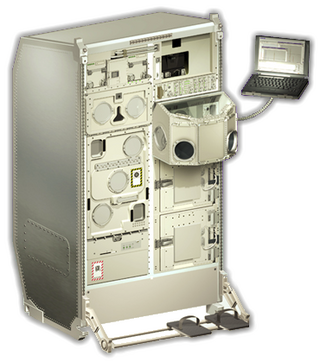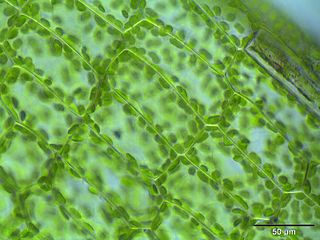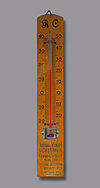
A bain-marie, also known as a water bath or double boiler, a type of heated bath, is a piece of equipment used in science, industry, and cooking to heat materials gently or to keep materials warm over a period of time. A bain-marie is also used to melt ingredients for cooking.

Humidity is the concentration of water vapor present in the air. Water vapor, the gaseous state of water, is generally invisible to the human eye. Humidity indicates the likelihood for precipitation, dew, or fog to be present.

A thermostat is a regulating device component which senses the temperature of a physical system and performs actions so that the system's temperature is maintained near a desired setpoint.

A hygrometer is an instrument which measures the humidity of air or some other gas: that is, how much water vapor it contains. Humidity measurement instruments usually rely on measurements of some other quantities such as temperature, pressure, mass, and mechanical or electrical changes in a substance as moisture is absorbed. By calibration and calculation, these measured quantities can be used to indicate the humidity. Modern electronic devices use the temperature of condensation, or they sense changes in electrical capacitance or resistance.
The word incubation may refer to:

Egg incubation is the process by which an egg, of oviparous (egg-laying) animals, develops an embryo within the egg, after the egg's formation and ovipositional release. Egg incubation is done under favorable environmental conditions, possibly by brooding and hatching the egg.

STS-65 was a Space Shuttle program mission of Columbia launched from Kennedy Space Center, Florida, 8 July 1994. The flight carried a crew of 7 and was commanded by Robert D. Cabana who would go on later to lead the Kennedy Space Center. STS-65 was an international science mission that carried the International Microgravity Laboratory (IML-2) on an 15-day mission. Columbia returned to the Kennedy Space Center on 23 July 1994.
An incubator is anything that performs or facilitates various forms of incubation, and may refer to:

The drugstore beetle, also known as the bread beetle, biscuit beetle, and misnamed as the biscuit weevil, is a tiny, brown beetle. It can be found infesting a wide variety of dried plant products, where it is among the most common non-weevils to be found. It is the only living member of the genus Stegobium. It belongs to the family Ptinidae, which also includes the deathwatch beetle and furniture beetle. A notable characteristic of this species is the symbiotic relationship the beetles have with the yeast they carry, which are transmitted from female to larvae through the oviduct.
Respirometry is a general term that encompasses a number of techniques for obtaining estimates of the rates of metabolism of vertebrates, invertebrates, plants, tissues, cells, or microorganisms via an indirect measure of heat production (calorimetry).

Malaria culture is a method for growing malaria parasites outside the body, i.e., in an ex vivo environment. Although attempts for propagation of the parasites outside of humans or animal models reach as far back as 1912, the success of the initial attempts was limited to one or just a few cycles. The first successful continuous culture was established in 1976. Initial hopes that the ex vivo culture would lead quickly to the discovery of a vaccine were premature. However, the development of new drugs was greatly facilitated.

Biolab is a single-rack multi-user science payload designed for use in the Columbus laboratory of the International Space Station. Biolab supports biological research on small plants, small invertebrates, microorganisms, animal cells, and tissue cultures. It includes an incubator equipped with centrifuges in which the preceding experimental subjects can be subjected to controlled levels of accelerations.

The following outline is provided as an overview of and topical guide to cell biology:

An incubator is a device simulating avian incubation by keeping eggs warm at a particular temperature range and in the correct humidity with a turning mechanism to hatch them.

The chorioallantoic membrane (CAM), also known as the chorioallantois, is a highly vascularized membrane found in the eggs of certain amniotes like birds and reptiles. It is formed by the fusion of the mesodermal layers of two extra-embryonic membranes – the chorion and the allantois. It is the avian homologue of the mammalian placenta. It is the outermost extra-embryonic membrane which lines the non-vascular egg shell membrane.

An Egyptian egg oven or Egyptian mamal is an oven for hatching eggs by incubation using artificial heat. Manmade hatching ovens in Egypt date back to the 4th century BC. Although using old processing methods, they were considered effective at hatching chickens, especially in comparison to other techniques of the time.
Minusheet perfusion culture system is used for advanced cell culture experiments in combination with adherent cells and to generate specialized tissues in combination with selected biomaterials, special tissue carriers and compatible perfusion culture containers.
Surgical humidification is the conditioning of insufflation gas with water vapour (humidity) and heat during surgery. Surgical humidification is used to reduce the risk of tissue drying and evaporative cooling.
Shell-less chick embryo culture is the process of growing chick embryos in vitro, without their protective egg shells, for scientific observation.
The rock dove, Columbia livia, has a number of special adaptations for regulating water uptake and loss.

















